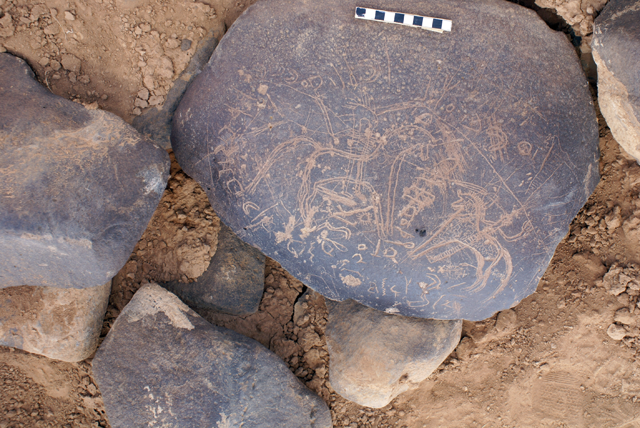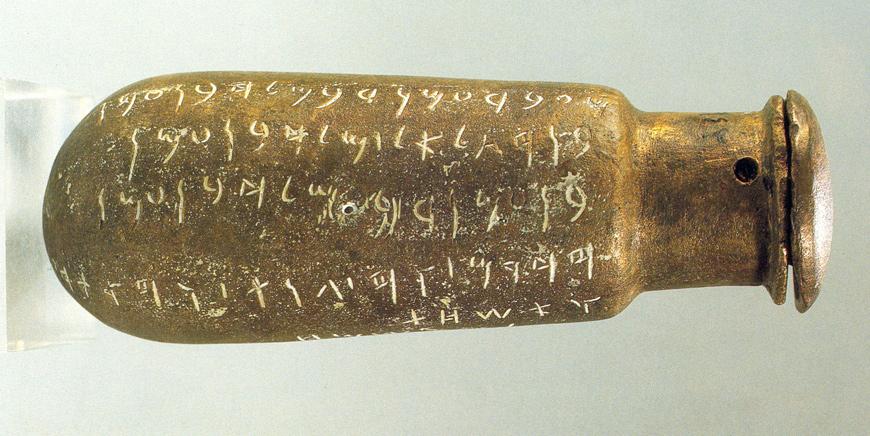You are here
Unveiling Jordan’s rich basalt desert: A call for preservation, exploration
By Saeb Rawashdeh - Nov 13,2023 - Last updated at Nov 13,2023

Safaitic — Ancient North Arabian Inscription accompanied by a rock drawing showing a fighting scene between two horsemen (Photo courtesy of Hani Hayajneh)
AMMAN — Although it is clear that the eastern parts of Jordan are arid areas, the area of the basalt desert is full of inscriptions and engravings. Scholars have been finding thousands of rock inscriptions and they called them the “Ancient North Arabian” under the South Semitic branch.
“I believe that a special intention should be given to the volcanic desert in the North-eastern Jordan and its importance for the Jordanian tourism. The epigraphical heritage and its preservation should constitute a major part of Jordan’s development plans,” noted Professor Hani Hayajneh, adding that the so-called lava-desert in North-eastern Jordan is a natural extension of the Lava area which covers a huge part of Bilad Al Sham strewn with debris of countless volcanic eruptions.
Talking about the geography, Hayajneh said that The Harret Rajil is only the most northerly of the chain of such harret, stretching from southern Syria across Jordan and northern Saudi Arabia. It spreads over 45.000km while 11.000 of them are of Jordan’s 95.000km.
Different foreign explorers began to research the Black Desert from the mid-19 century and it compasses a functioning ecosystem with an extraordinary array of biological and historic written resources.
“In my opinion, it is a remarkable outdoor laboratory, offering an opportunity to observe, study and experience the geologic processes that shape natural landscapes, as well as other cultural objects of interests,” Hayajneh underlined.
Among isolated vistas, there is a very sophisticated eco-system that needs to be preserved.
“Preserving it will help safeguard the valuable ecology and history of its irreplaceable landscapes for future generations,” professor noted, adding that the following measures should be taken into account:
Building foundations for those who cherish the natural and cultural aspects of this desert to assume a leadership role in preserving them for both current and future generations.
One is conducting archaeological and epigraphical surveys to document the archaeological sites that might disappear through the human intervention and trying to establish exhibitions that portray its landscape, its fauna and flora. It should underline the need to act to ensure that much of this diverse and unique environment is not lost forever.
According to Hayajneh, the Black Desert can be arranged for touristic visits where tourists would gain an array of knowledge about both flora and fauna, and archaeological importance of the area.
Talking about the cultural heritage, Hayajneh said: “The major epigraphical type which is widely spread in this area is the so-called Safaitic inscriptions. Chronologically they cover according to some scanty historical indications the period between the 1st century BC and the 4th century AD.”
The inscriptions provide information on different levels: Religious, historical, social and political. They can be classified according to the contents as memorial inscriptions, claims to property, funerary inscriptions and prayers, the scholar underlined.
“For instance, blessings and curses attached to many memorial inscriptions are prayers to the gods that they may bless or punish. Contrary to other Ancient Near Eastern Texts, the Ancient north Arabian Inscriptions, especially those of the Safaitic group, doesn’t contain letters or literature,” Hayajneh elaborated.
“We encounter hundreds of Arab-Islamic inscriptions left by transgressors across the region that constitute a major source for the history of the region. The documenting and preservation of such written heritage should take another dimension based on the modern available techniques of geographic information system and electronic means, especially the GPS system. This proves at the same time that the Arabs in these regions were not illiterate as we are accustomed to describing and teaching our children,” Hayajneh concluded.
Related Articles
AMMAN — Allat was a pre-Islamic Arabian goddess worshipped alongside Uzza, Manat and Dushara.
AMMAN — The eastern Basalt Desert was a home of a “very intensive” Christian graffiti production during first three centuries AD.
AMMAN — The German Protestant Institute of Archaeology recently held the second lecture of a series dubbed "Epigraphic Testimonies from Jord














